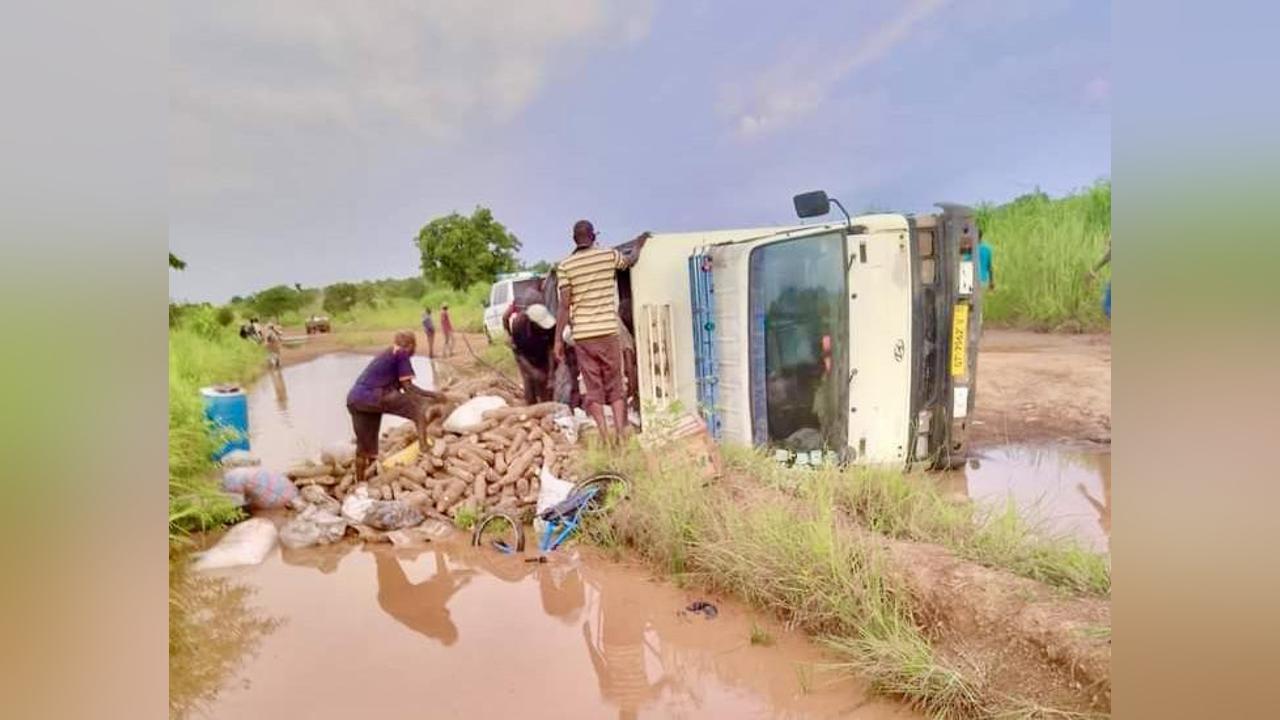Africa-Press – Ghana. Kambon-Naakura is a farming community in the Mion District of Northern Ghana. Kambon Naa, the local chief is a seasoned farmer. He cultivates cassava, yam, maize, soybeans and sorghum.
Despite the hardwork and enterprise of the traditional ruler, he has faced two decades of hardship and disappointment. His farm produce goes on a single dilapidated feeder road to access markets in Mion, Jimle, Yendi, and Tamale.
Kanbon Naa sadly told: “I once lost all my produce in a bushfire.” We delayed getting a truck to Tamale because of the road. By the time it arrived, the fire had destroyed everything.”
He added: “Aggregators want to buy from us, but the bad roads discourage them. When they do come, they offer very low prices, which only deepens our poverty.”
Neighboring communities like Sagbarugu, Chegu Fulanikura, and Adamkura face similar or worse challenges, with roads becoming virtually unmotorable during the rainy season.
As of December 2021, Ghana’s feeder road network spanned approximately 43,305 kilometers. According to the Department of Feeder Roads, only 29.5 percent are in good condition, 38 percent are fair, and a troubling 32.2 percent are in poor condition.
This means nearly one-third of Ghana’s feeder roads are in deplorable conditions, posing significant barriers to transportation, agriculture and rural development.
Feeder Roads: The Lifeline of Rural Agriculture
Feeder roads, typically unpaved, single-lane roads, are vital links between rural farmers and main road networks. They are crucial for transporting inputs, produce, accessing health services, and enabling children to attend school.
Alhaji Yussif Amuda Fuseini, Director of Agricultural Services at the Tamale Metropolitan Assembly, emphasized that poor feeder roads impact every stage of agricultural production.
“They limit access to fertilizers and seeds, reduce farmers’ income, and discourage production,” he told. “It worsens food insecurity. If food can’t be transported efficiently, it causes scarcity and price hikes in cities.”
He added that post-harvest losses, especially for perishable crops like tomatoes and peppers, are increasing due to delays caused by bad roads.
Mr. Issah Abdul-Hakim, Administrator of the Ghana Soybeans Farmers and Aggregators Association, also noted that poor roads raise transport costs, making aggregation unprofitable.
“Many youths have exited the business. If nothing is done soon, unemployment will worsen, especially among women and young people.”
Bad roads: A national Challenge
Ghana has about 94,203 kilometers of roads, of which a large portion are feeder roads. In 2010, the EU-funded Feeder Roads Improvement Programme completed 648 km in the Eastern Region. More recently, 670 km of feeder roads were commissioned in the Upper West Region in 2024. Yet many roads, especially those in farming communities, remain neglected.
In the Central Region, 52 of 121 feeder road projects were abandoned due to delayed government payments, undermining agricultural productivity and food access nationwide.
Food Security at Risk
Ghana’s food security is deeply tied to rural infrastructure. The Ghana Statistical Service’s 2022 Household Income and Expenditure Survey revealed that 49.1% of food-insecure individuals live in rural areas. The 2020 Comprehensive Food Security and Vulnerability Analysis (CFSVA) estimated that 3.6 million Ghanaians—11.7% of the population, are food insecure.
The Northern Region alone accounted for 598,706 food-insecure individuals, the highest nationwide. Poor rural roads contribute directly to this crisis.
Households led by individuals with little education, male-headed homes, and those with large family sizes are particularly vulnerable.
Recommendations/Way Forward
Addressing these challenges require urgent and coordinated actions: Firstly, it is important for Government to establish a dedicated road maintenance fund to ensure consistent upgrades and maintenance of feeder roads across rural Ghana.
It is also critical to encourage private sector investment in the road sector, by engaging local and foreign partners in road construction and maintenance to ensure sustainability.
Furthermore, the government must implement a road condition monitoring system to track and respond to deteriorating roads before they become unusable.
Again, it is important for Government to prioritise constructing climate-resilient roads that can withstand Ghana’s increasingly unpredictable and extreme weather.
In conclusion, improving feeder roads is not just about fixing potholes, it’s about strengthening Ghana’s agricultural backbone, reducing rural poverty, and improving national food security.
For farmers like Kambon Naa and other traders, better roads could mean more than increased profits. It could mean dignity, opportunity and hope for a better future.
For More News And Analysis About Ghana Follow Africa-Press







